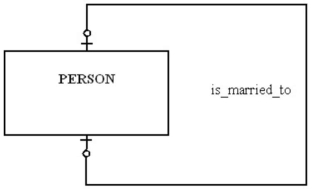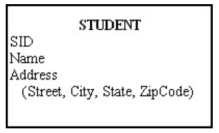A) It depicts a unary relationship.
B) It depicts a many-to-many relationship.
C) There is an associative entity.
D) All of the above.
Correct Answer

verified
Correct Answer
verified
True/False
One reason to use an associative entity is if the associative entity has one or more attributes in addition to the identifier.
Correct Answer

verified
Correct Answer
verified
Multiple Choice
The number of entity types that participate in a relationship is called the:
A) number.
B) identifying characteristic.
C) degree.
D) counter.
Correct Answer

verified
Correct Answer
verified
True/False
A fact is an association between two or more terms.
Correct Answer

verified
Correct Answer
verified
Short Answer
A meaningful relationship between entity types is called a(n)________.
Correct Answer

verified
Correct Answer
verified
Multiple Choice
The common types of entities are:
A) strong entities.
B) weak entities.
C) associative entities.
D) all of the above.
Correct Answer

verified
Correct Answer
verified
True/False
When choosing an identifier,choose one that will not change its value often.
Correct Answer

verified
Correct Answer
verified
True/False
In an E-R Diagram,an associative entity is represented by a rounded rectangle.
Correct Answer

verified
Correct Answer
verified
Multiple Choice
For the relationship represented in the figure below,which of the following is true?

A) An employee can work in more than one department but does not have to work for any department.
B) A department must have at least one employee.
C) A department can have more than one employee.
D) An employee has to work for more than one department.
Correct Answer

verified
Correct Answer
verified
Essay
What is the difference between a simple attribute and a composite attribute?
Correct Answer

verified
A simple attribute cannot be broken down...View Answer
Show Answer
Correct Answer
verified
View Answer
Essay
How is a strong entity different from a weak entity?
Correct Answer

verified
A strong entity type exists independentl...View Answer
Show Answer
Correct Answer
verified
View Answer
True/False
Data names should always relate to business characteristics.
Correct Answer

verified
Correct Answer
verified
Multiple Choice
The following figure shows an example of:

A) a one-to-many relationship.
B) a strong entity and its associated weak entity.
C) a co-dependent relationship.
D) a double-walled relationship.
Correct Answer

verified
Correct Answer
verified
Short Answer
A ________ is an association between two or more terms.
Correct Answer

verified
Correct Answer
verified
Multiple Choice
In an E-R diagram,there are ________ business rule(s) for every relationship.
A) two
B) three
C) one
D) none
Correct Answer

verified
Correct Answer
verified
True/False
Data rather than processes are the most complex aspects of many modern information systems.
Correct Answer

verified
Correct Answer
verified
Multiple Choice
In the figure shown below,which of the following is true?

A) A person can marry at most one person.
B) A person has to be married.
C) A person can marry more than one person, but that person can only be married to one person.
D) A person can marry more than one person.
Correct Answer

verified
Correct Answer
verified
Multiple Choice
The logical representation of an organization's data is called a(n) :
A) database model.
B) entity-relationship model.
C) relationship systems design.
D) database entity diagram.
Correct Answer

verified
Correct Answer
verified
Short Answer
A person,place,object,event,or concept about which the organization wants or needs to store data is called a(n)________.
Correct Answer

verified
Correct Answer
verified
Multiple Choice
The following figure shows an example of:

A) a composite attribute.
B) a relational attribute.
C) a derived attribute.
D) a multivalued attribute.
Correct Answer

verified
Correct Answer
verified
Showing 81 - 100 of 121
Related Exams